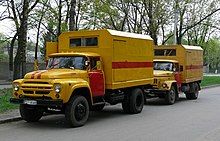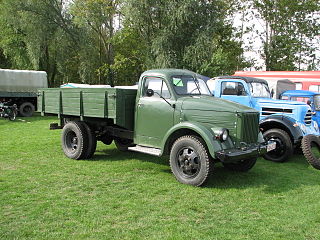
The GAZ-51 was a Soviet truck manufactured by GAZ. Its first prototypes were produced before the end of World War II, and the truck ended up using a heavily modified version of the Studebaker US6 cab, which was supplied to the Soviet Union in large quantities with the Lend-Lease agreement, although the chassis was completely new.

The Studebaker US6 (G630) was a series of 2+1⁄2-ton 6×6 and 5-ton 6×4 trucks manufactured by the Studebaker Corporation and REO Motor Car Company during World War II. The basic cargo version was designed to transport a 2+1⁄2-short-ton cargo load over any type of terrain in any weather. Most of these were exported to the Soviet Union under Lend-Lease by the US during World War II, since the competing GMC 6×6 CCKW design proved to be more suitable for Western Front conditions.

The Medium Tactical Vehicle Replacement (MTVR) is a series of vehicles used by the U.S. Marines. The first MTVRs were delivered in late 1999. The MTVR is the equivalent of the U.S. Army's Family of Medium Tactical Vehicles (FMTV); the Marines do not use the FMTV and the Army does not use the MTVR.

A tractor unit, also known as a truck unit, lorry unit, power unit, prime mover, ten-wheeler, semi-tractor, semi-truck, semi-lorry, tractor cab, truck cab, lorry cab, big rig tractor, big rig truck or big rig lorry or simply a tractor, truck, lorry, semi, big rig or rig, is a characteristically heavy-duty towing engine that provides motive power for hauling a towed or trailered load. These fall into two categories: heavy- and medium-duty military and commercial rear-wheel-drive semi-tractors used for hauling semi-trailers, and very heavy-duty typically off-road-capable, often 6×6, military and commercial tractor units, including ballast tractors.
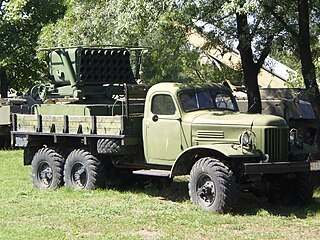
The ZIL-157 is a general-purpose 2+1⁄2-ton 6×6 truck, produced at the Lichachev plant in the Soviet Union from 1958 to 1977, when production was transferred to the Amur plant, since the Lichachev plant wanted to focus more on modern trucks, such as the ZIL-131 range. Nevertheless, production of the ZIL-157 trucks continued even after the fall of the Soviet Union, but eventually ended in 1994.

The ZIS-151 was a general-purpose truck produced by the Soviet car manufacturer Automotive Factory No. 2 Zavod imeni Stalina in 1948–1958. In 1956, the factory was renamed to Zavod imeni Likhacheva, and new trucks were called ZIL-151 (ЗИЛ-151).

The Diamond T Company was an American automobile and truck manufacturer. They produced commercial and military trucks.

The M39 series 5-ton 6×6 truck (G744) was a family of heavy tactical trucks built for the United States Armed Forces. The basic cargo version was designed to transport a 5-ton (4,500 kg), 14 ft (4.3 m) long load over all terrain in all weather. In on-road service the load weight was doubled.

The ZIS-150 is a Soviet truck. In 1947 it replaced the ZIS-5 truck on the assembly line. Together with the GAZ-51, it was the main Soviet truck during the 1950s, judging by their quantity. A tractor-trailer version of the ZIS-150, the ZIS-120N was sold from 1956 to 1957. In 1957, the base ZIS-150 model was replaced by ZIL-164, which differed outwardly only by vertical grille bars and bumper.

OJSC «Autodiesel» known as the Yaroslavl Motor Plant (YaMZ), Russian: Яросла́вский мото́рный заво́д (ЯМЗ), romanized: Yaroslavskyi Motornyi Zavod (YaMZ), based in Yaroslavl, Russia, is an open joint-stock company that produces engines for many Russian companies.

MAZ-500 is a Soviet truck manufactured at the Minsk Automobile Plant. The first prototype MAZ-500 ran as early as 1955 and they were shown to the public in 1958. Delays in engine development pushed full production back to 1965, although limited production started in 1963. The MAZ-500 is a cab over truck instead of the MAZ-200's conventional layout. This was done to increase payload and reduce weight as well as reduce fuel consumption. The engine itself was quite modern, a direct injection 11,150 cc (680 cu in) diesel V6 built by the Yaroslavl Motor Plant with 180 PS (132 kW) at 2100 rpm. The truck's design was also innovative, with a tilting cabin, which was still rare in the West as well. It also had a number of features designed to make the truck operable under the arduous conditions found in Siberia.

MAZ-5335 is a Soviet truck, manufactured at the Minsk Automobile Plant from 1977 to 1990.

The Mack M123 (G792) was a 10-ton 6x6 semi-tractor introduced in 1955. The Mack M125 was a heavy cargo truck version of the M123. The M123 was used to tow tank transporter trailers while the M125 towed field artillery pieces.
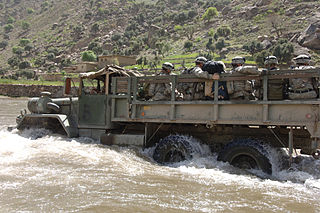
The M809 Series 5-ton 6x6 truck (G908) was a family of heavy tactical trucks built for the United States Armed Forces. The basic cargo version was designed to transport a 5-ton (4,500 kg), 14 ft (4.3 m) long load over all terrain in all weather. In on-road service the load weight was doubled. Built by AM General, they evolved into the M939 Series.

The 6-ton 6×6 truck was a family of heavy tactical trucks built for the United States Army during World War II. The basic cargo version was designed to transport a 6- short ton (5,400 kg) cargo load over all terrain in all weather. The chassis were built by Brockway Motor Company, The Corbitt Company, The Four Wheel Drive Auto Company (FWD), Ward LaFrance Truck Corporation, and White Motor Company. They were replaced by the M54 5-ton 6x6 trucks in the 1950s.

The 2+1⁄2-ton, 6×6 truck was a standard class of medium duty trucks, designed at the beginning of World War II for the US Armed Forces, in service for over half a century, from 1940 into the 1990s. Also frequently known as the deuce and a half, or just deuce, this nickname was popularized post WWII, most likely in the Vietnam war era. The basic cargo versions were designed to transport a cargo load of nominally 2+1⁄2 short tons over all terrain, in all weather. The 2+1⁄2-ton trucks were used ubiquitously in World War II, and continued to be the U.S. standard medium duty truck class after the war, including wide usage in the Korean and Vietnam Wars, as well as the first Gulf War.
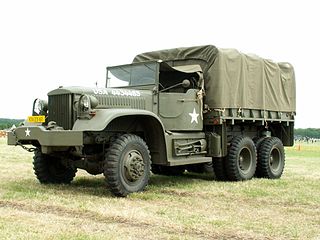
The Diamond T 4-ton 6×6 truck was a heavy tactical truck built for the United States Army during World War II. Its G-number was G-509. Cargo models were designed to transport a 4-ton (3,600 kg) load over all terrain in all weather. There were also wrecker, dump, and other models. They were replaced by the M39 series 5-ton 6×6 trucks in the 1950s.

ZIL-133 is a Soviet/Russian 3 axle straight truck produced by ZIL in Moscow from 1975 to 2000. The first prototypes were developed in the early 1970s years in the Soviet Union. It was intended as a 3 axle version of the ZIL-130 with a higher payload.


